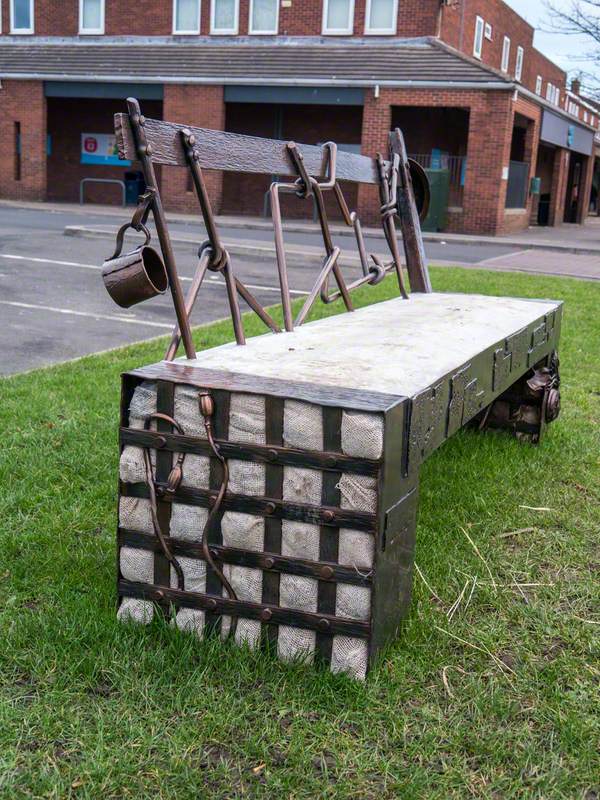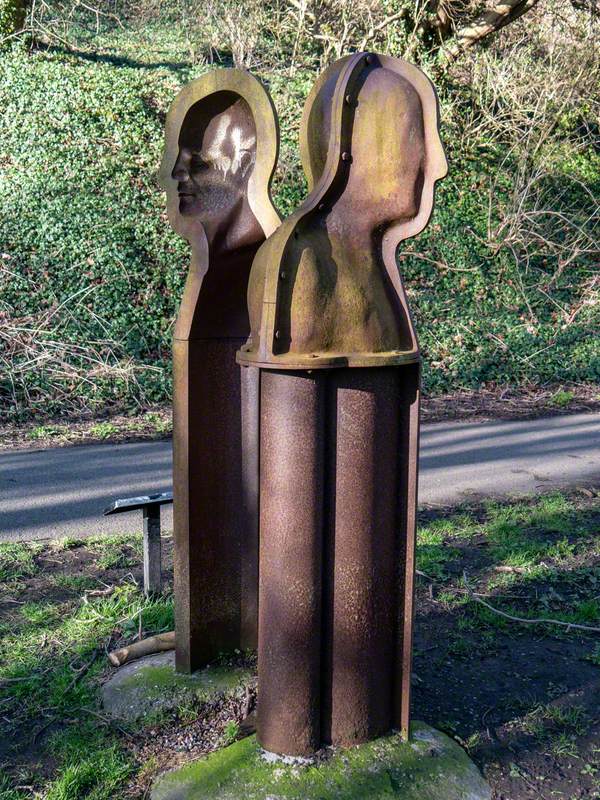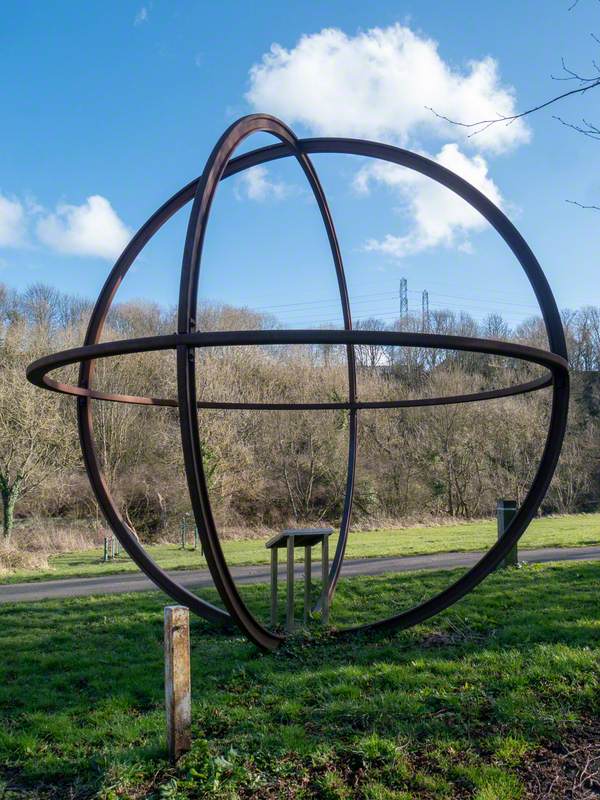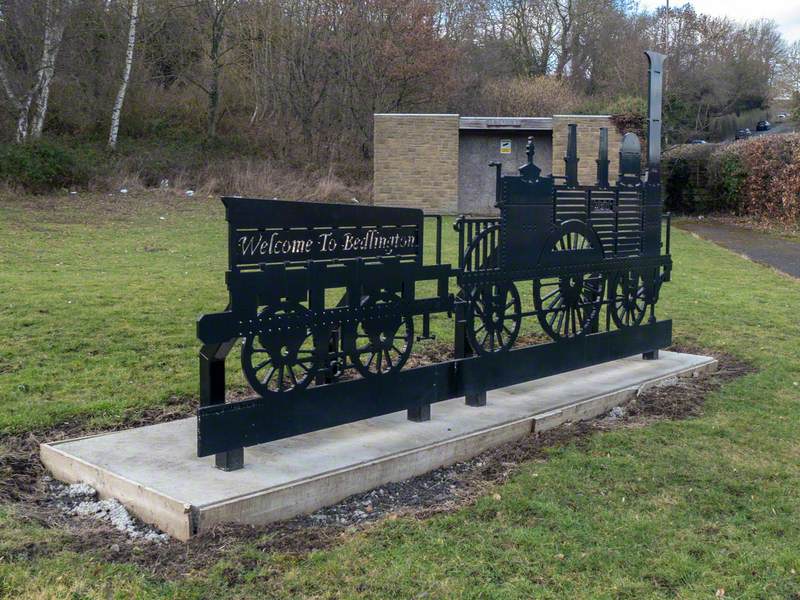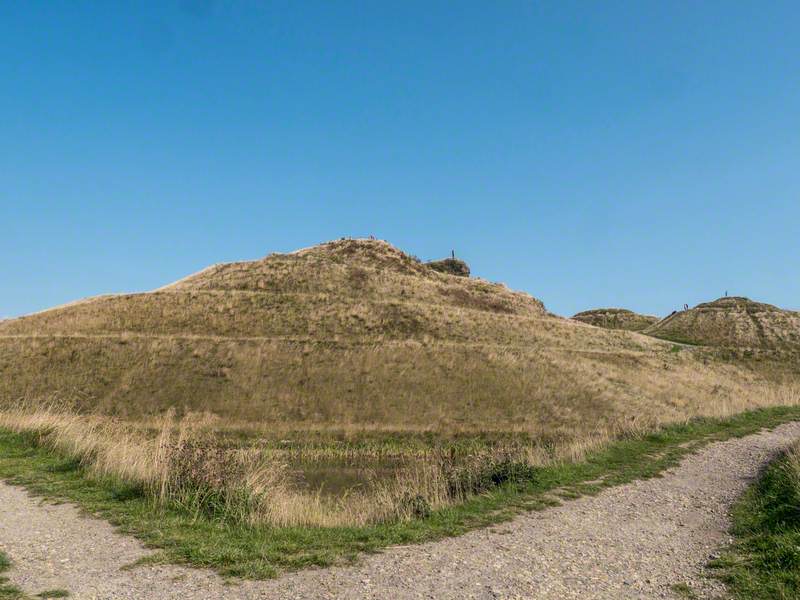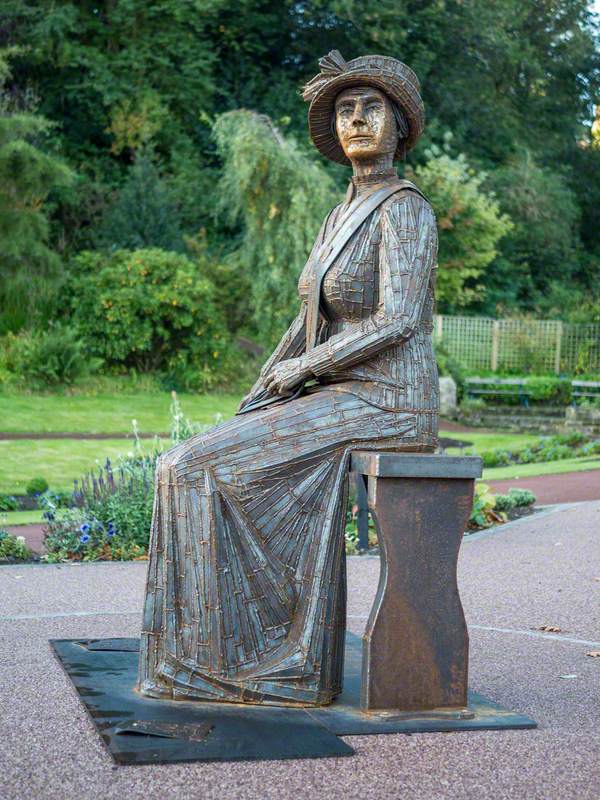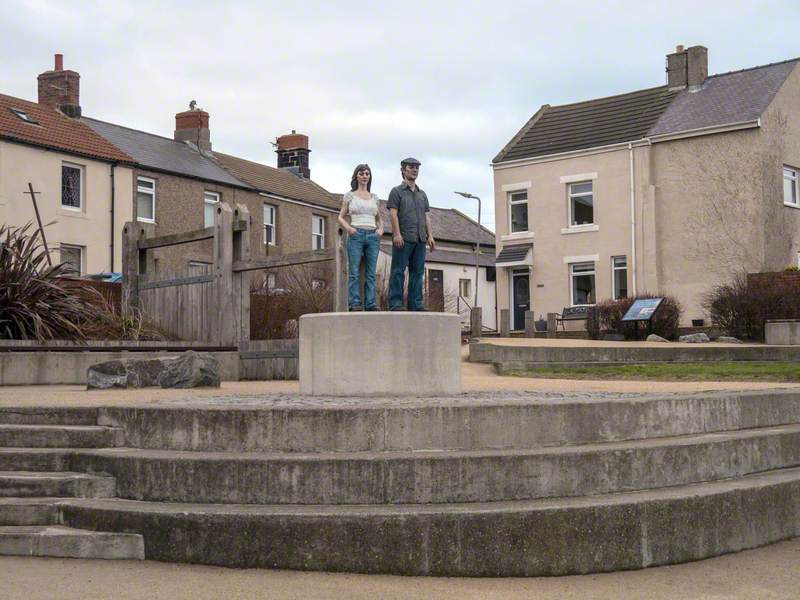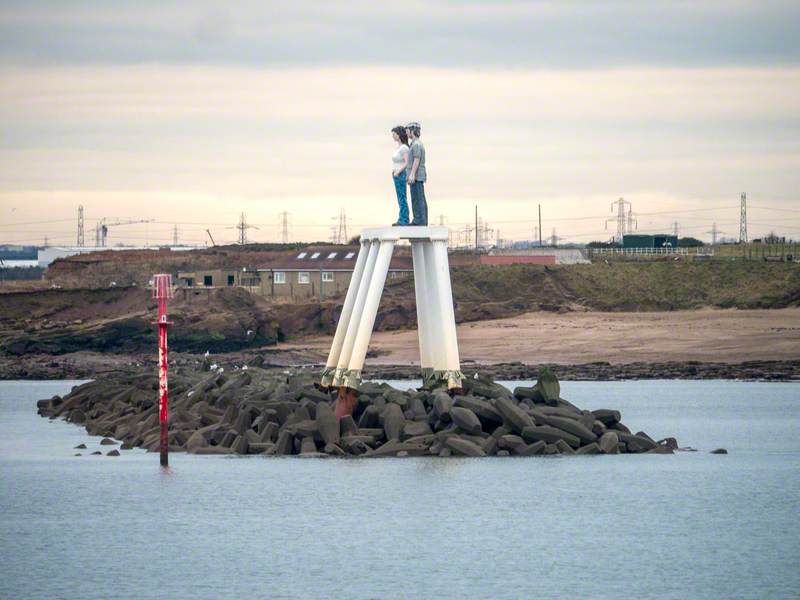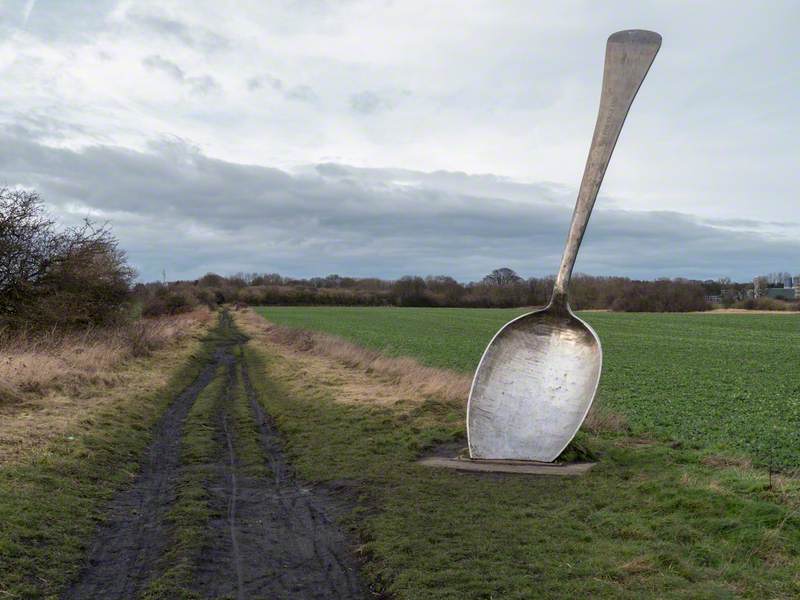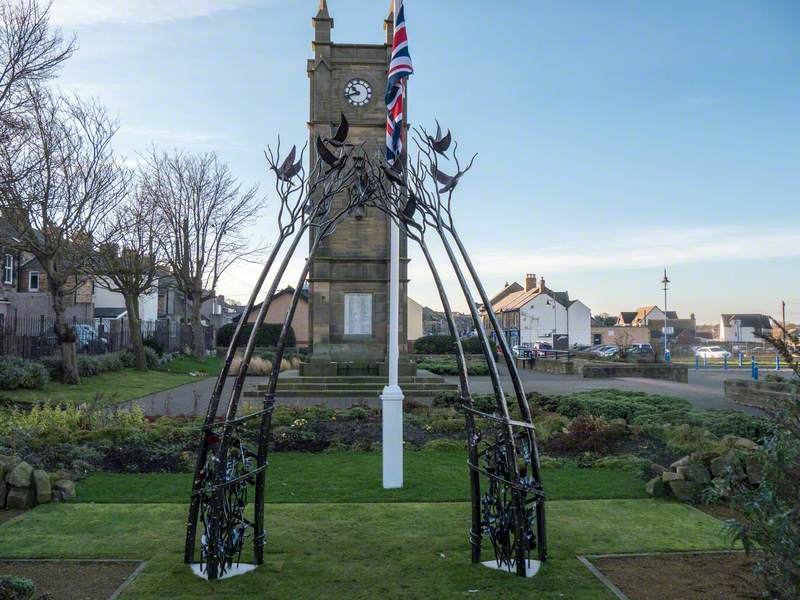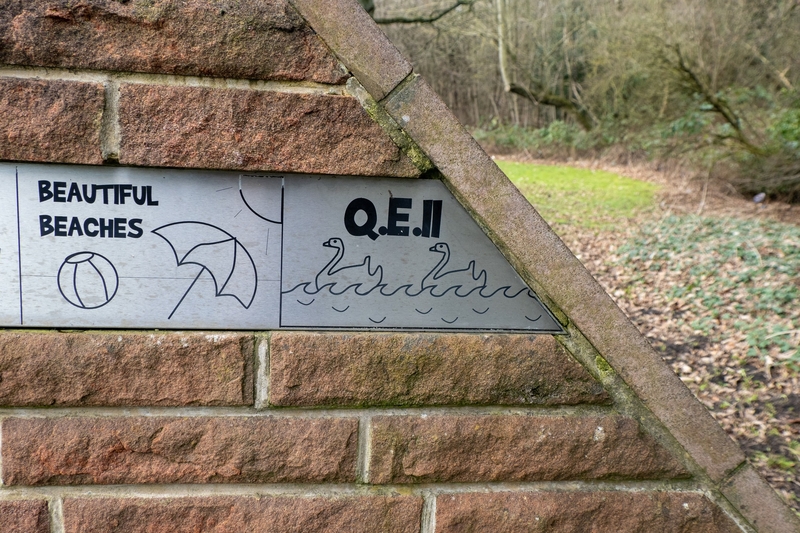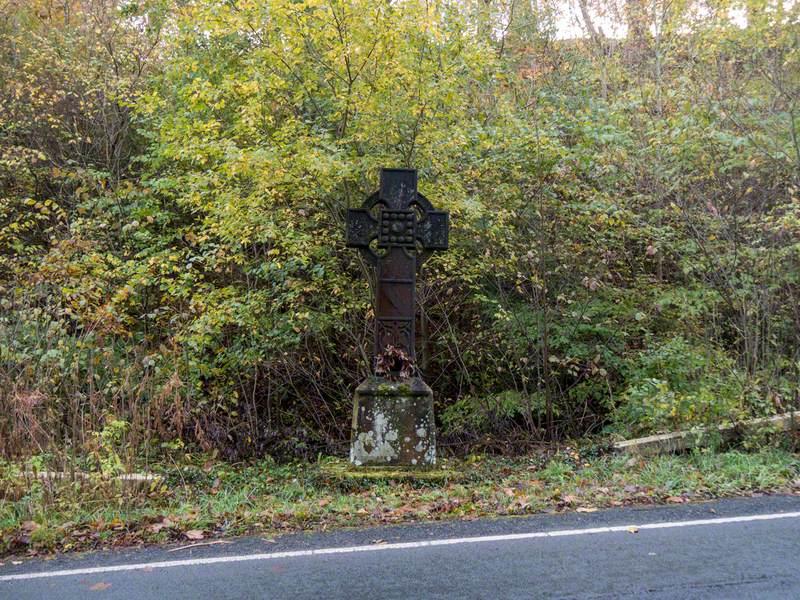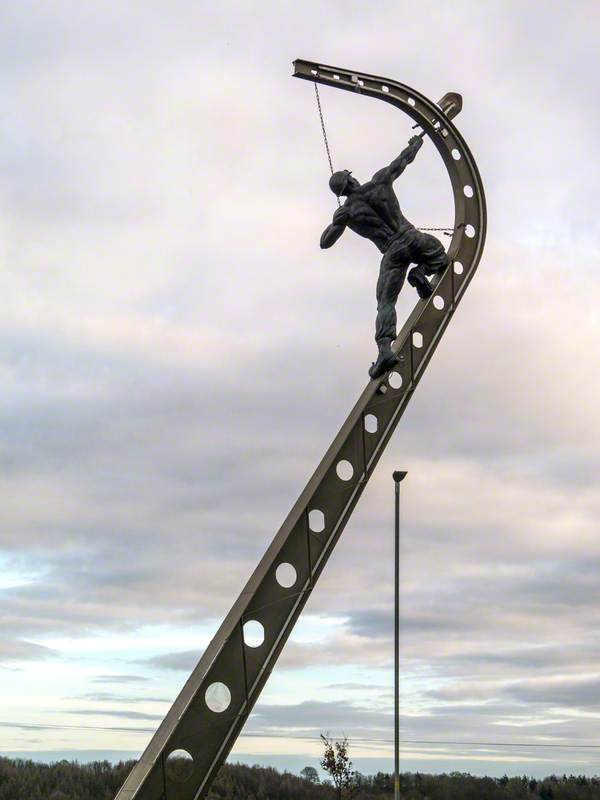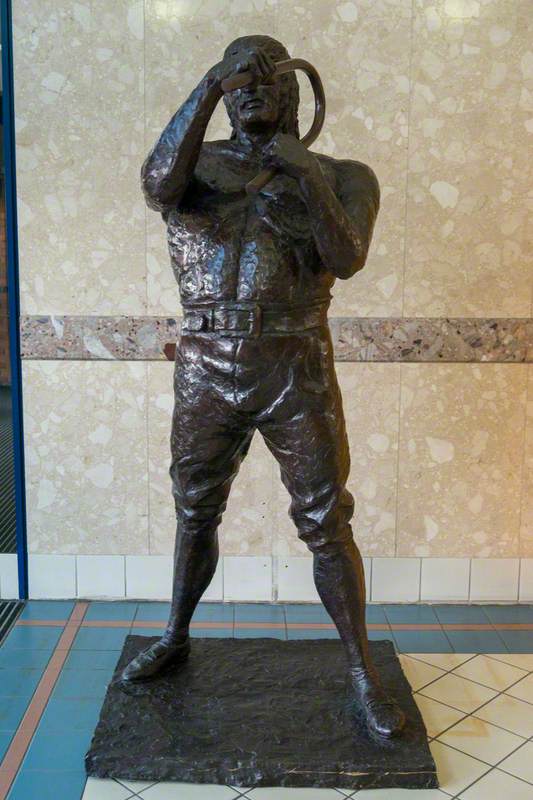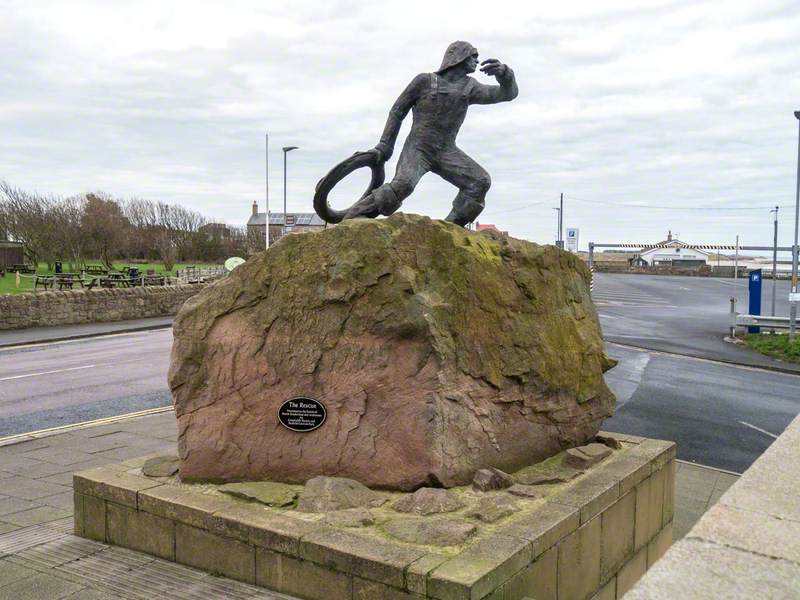After photographing over 160 sculptures in the county of Northumberland, I chose some of my favourites and decided to let them speak for themselves. Often heartwarming and visionary, sometimes sad, and occasionally irreverent, this is their story....
-
Tommy's tale
First World War Bench 2018It was a lassie made my bench, her first commission as well. Seems strange to us old’uns to see a young mam working that steel, but she follows four generations of blacksmiths.
There’s room for other Tommies too; maybe my mate, Jack Smith. We’re near the Co-operative store, so we can get some rations in. She’s even hung my tin mug on the back for a brew. I see a cap badge there as well, beautifully rendered, Northumberland Fusiliers. Not that a cap would be any good in the trench; you need a tin hat on in there.
The poppies remind me of Flanders fields; so does the barbed wire she's sculpted. They tell me young Jack will survive and go on to start his forge, where his great granddaughter made my bench. I hope I'm lucky too
Ashlee Donaldson
Galvanised mild steel
-
We are the hands
FarewellWe are the hands that set the girders
that held the pout rod, drew the chocks.
We are the hands that drilled the coalface,
hewed the seam and fired the shots.
We are the hands that fed the pony,
pulled the hogger, filled the tubs.
We are the hands that carried the lamp
and we are the wings
that flew before their time
when the light went out.
Paula Chambers (b.1966)
Cast aluminium
-
A heroine's view
Grace Darling Memorial 1844Quite a view from up here, with the gentle hills behind me and the sea to my left. The church in front, St Aidan’s, is where I was baptised on a cold December day in 1815; Grandfather Job’s cottage where I was born is on my right here. There’s also a sad sight from my pedestal - Uncle’s cottage just down the road. They brought in the bed in which I had been born for my last days, so full circle really.
The stone oar gets in my way, but isn’t as heavy of those in the coble on the night when the Forfarshire sank. What a battle it was keeping the boat steady while Father helped on the survivors.
This canopy keeps the rain off, but not enough to protect my first effigy, which is under cover in the church now.
Charles Raymond Smith (c.1799–1888) and Anthony Salvin (1799–1881) and Messrs Hicks & Charlewood and Frederick Richard Wilson (1827–1894)
Portland stone, sandstone & cast iron
H 300 x W 300 x D 125 cm
-
I am the god of transitions
JanusStrange to find myself on a path in a far flung part of our Roman Empire. I suppose I am the god of passages! Two-faced, you call me, but I hope not in the sense you humans use the term.
How then? Well, I preside over your beginnings and endings. One of my faces sees the iron works when it started up its business here, and as god of travel I enabled their locomotives to move across the world.
It certainly changed round here once that ironworks closed in 1867. And now the ground that yielded the coal and iron ore is countryside again. I am initiator of new historical ages.
So you have me in Bedlington, the most important god in the Roman pantheon, moulded from your material of past times, and looking onwards to a bright future
Peter Burke (b.1944)
Cast weathering steel
H 180 cm
-
'We live by fire and water and iron and God's favour' (over the clock house door -1829)
Glo-Bed-Rail SculptureCountryside here, just like centuries ago. All changed in 1736 when with trees for charcoal and water in the Dene they got permission for iron smelting. Hand made nails it was at first, accompanied by the noise of splitting mills and nailers, to the tune of Hartley pans for sailors Bedlington for nailers.
The quantities of charcoal couldn’t be sustained, but business rose like a pheonix again when old Darby in Shropshire suggested coke instead. Rolling iron bars instead of forging them made the revolution complete and we were in business again - iron rods, and keel boats for transport.
So, here I am, thanks to Tom Maley - hoops of Bedlington rail. Look at my shape and visualise the rails we laid to Glebe pit, and then across the globe
Tom Maley (b.1962)
Steel
-
The locomotive's story
Bedlington Train SignTo move from this platform you need a few of those Bedlington rails from my friend Glo-Bed-Rail down the way and get Janus to wish us godspeed. Then we could relive some of those Bedlington locomotive journeys.
Once we had set the standard for rails, locomotives came next. Any young apprentice could be seen working on my boiler plates. We proved ourselves with the famous ‘Sans Pareil’'s boiler and being the first to depart from the new Kings Cross station, then contracts abroad. They send their young men to train here; even pay for the privilege.
Wait! You’re in for a grand sight. One of the engines has been completed. Look, it is being dragged up the steep bank to Bebside. What a team of horses, hired from every farmer hereabouts
unknown artist
Wrought iron
-
A soldier's tale
Soldier, Fox and Dog c.1750Just a lowly statue, alone on a farm wall, but it wasn’t always thus. There were seven of us standing on the roof above the entrance gate, a grand crenellated building, three levels with rooms above the arch.
Some say John Graham Lough made us, but I think they have the timing wrong. He’ll be that kid from the forge who came with his father to Black Hedley. Maybe inspired him to apprentice with the stone mason at Shotley Field, then off to London and fame.
Humfrey Hopper didnt stop at us. The mausoleum he built in the churchyard is monumental, with obelisks and shields and statues in shell-headed niches. It’s on Kiln Pit Hill, half eaten away by the rain and driving winds.
I’m a bit weather worn but unlike the rest still here
unknown artist
Sandstone
H 150 cm
-
My Lady's perspective
Northumberlandia (The Lady of the North) 2010A goddess rising from a coal mine, I am the Lady of the North.
From the air, I am spiralling, twisting paths, traversing a giant supine body of grassy mounds, a Silbury Hill for the post-modern, not the neolithic, age.
On the ground nearby, open cast trucks, dwarfed by my presence, toil away in their Mordor. Meanwhile, on my slopes, you walk your families and your dogs and push wheelchairs round my paths as your children climb my breasts like Liliputian mountaineers, Finally, you venture into my forehead, matching your vantage point with mine before you go.
But by night I am a dark, mysterious creature, silhouetted against the stars, a temple connecting earth and sky, the landscape and the universe..
Charles Jencks (1939–2019)
Rock, clay & soil
H 3353 x W 40234 cm
-
A suffragette's lament
Emily Wilding Davison (1872–1913) 2018Huh! They probably chose this bench in Morpeth for me to rub in the fact that I didn’t get to use the return part of my ticket to here from London. Or at least I did come back by rail, but in a box sadly, accompanied by huge processions at either end. I had wanted to pin the colours of our cause onto the King’s horse, but it thundered along so fast that I could barely see the red sleeves of the jockey I was looking for, and didn’t have a chance.
Ray Lonsdale gave me an understated look: elegant bonnet and gown in weathered steel. A signboard says ‘Northumberland’s lawless lassie’; not sure chucking a few rotten eggs at politicians quite merits that, but the dish of spilled food does represent my hunger-striking days.
Ray Lonsdale (b.1965)
Steel
-
Dear Ebb-at-Sea
Land Couple 2007Hey, twin, our spot in the square by the prom is quite sheltered, no crashing waves nor sea spray, and we’d have a lovely view out to sea if you weren’t spoiling it.
So what are you doing out in the middle of the sea? I’ve always known you’re not one for socialising, but you’ve turned your back on us completely. As for that lass of yours, you must be joking, taking her in that skimpy top with her midriff bare to the elements. You weren’t daft I see, covering your head with a cap and leaving her as a target for the gulls.
Not sure how you got out there on your giant trolley. They say we should ask someone called Sean Henry, but honestly you two would be better off on dry land.
Yours, Landside Ebb
Sean Henry (b.1965)
Bronze & paint
-
Dear Landside Ebb and Flo
Couple 2004–2007Thanks for your letter in the bottle. I’m answering as Ebb is sulking. Plus, I have tired of the view. I’m with Coleridge on this: it really is water water everywhere from where I’m standing.
I wish Ebb had shared the plan with me. He just said we were going out on a little trip and I didn’t dress for what was to come; it is freezing out here at times with a bare midriff.
I can report that the honeymoon’s over. He hasn’t so much as held my hand since we arrived, and never was much of a talker. I do have some avian company but I think they see me more as a target than a friend.
Sis, I wondered if you’d swap places for a bit. No-one would notice, especially Ebb. You like seafood, and I could murder a pizza.
Flo
Sean Henry (b.1965)
Bronze, steel & marine paint
H 500 cm
-
A spoon's welcome
Eat for England 2005–2006Surprise! Look what you have stumbled across. Well actually not sure why you find it surprising to see me out in the field. Logical really, producing food is what farms are for. Maybe you think 15ft high is a bit large for practical use. Even those who know I exist find it hard to locate me. Bob Budd intended me to be an unexpected delight.
Now where did I put that cereal bowl?
Bob Budd
Stainless steel
H 450 cm
-
Look through me
Amble Peace ArchLook through me and you'll see their names, hundreds inscribed on the clock tower and the Radcliffe memorial beyond it.
Look at my sides, and the poppies that bleed with remembrance.
Look up, and see my doves of peace.
Look through me again, and step towards a peaceful future.
Stephen Lunn (active since 1975)
Coated stainless steel, galvanised, & spray paint epoxy
H 307 x W 240 cm
-
We are Blyth
Spirit of the Staithes 2002We are legs, beams that once sat as staithes.
We are arms, blades that capture the power of the wind.
We are flowing waves.
We are a steam train, reaching back in time.
We are the future, steely bright, stretching forwards.
Simon Packard (b.1960)
Polished stainless steel
H 1524 x W 700 cm
-
I am he
Woodhorn Disaster Memorial 1923I am George, Daniel, Joseph, Robert.
I am Ralph, Walter, Edward.
Another George, another Joseph, yet another George.
I am David and Thomas, brothers.
I am the last victim, John, his pony nearby.
I am the rescue party; I am their disappointment.
I am the sons who lost their fathers, childhood over, miners now.
John Reid (c.1890–1968) and William Henry Knowles (1857–1943)
Bronze & white granite
-
One earl mourns another
Earls of Derwentwater Memorial 1883A sad day to see this! The last time I passed this way was in 1715 at the head of a company of gentlemen and armed servants from Dilston Hall. We were on our way to join the troops supporting my Prince James, to whom I'd been companion in France. Of course it ended badly, but when all petitions for clemency had failed and I came to my end on Tower Hill, I at least hoped Charles would get away safely to France.
The lettering on here is hard to make out, but look, 30 years later, he must have returned to fight for the Jacobite cause. I grieve for my brother now that I know he suffered the same fate as me, and that our dear King James, to whom we were loyal unto death, was never crowned
James Radclyffe, 3rd Earl of Derwentwater
unknown artist
Sandstone
H 210 cm
-
A bishop remembers
Saint Aidan (d.651 AD) 1958I remember you:
Isle of Iona, where I started my service.
King Oswald of Northumbria, who brought me here,
His royal town of Bamburgh, saved from the invaders' flames
by my prayers for wind.
The monasteries, schools and churches I built
with my brothers here on rocky Lindisfarne.
The villages of the North, where we spread the word,
and provided for the poor.
And now, you who cross the causeway and visit this Holy Island,
I pray for you.
Kathleen Parry (active 1958)
Red concrete & undressed stone
H 340 cm
-
Last 'Big E' man standing
Ellington Memorial 2009Who would have believed the demise of the mines?
They used to say ‘If you get a job at the pit, you’ve got a job for life’.
The last one, this was. We could have managed at least another 5 years after 2005 from that other coalface if that water hadn't burst out. Even though they tried to pump it out, all the equipment was lost, you see.
'Economically irretrievable,' they said. 340 jobs lost. I couldn't believe it when I stepped out of the cage for the last time,
Tom Maley (b.1962)
Bronze
H 255 cm
-
The reason for Robin
Fire (Robin of Pegswood) 2009Robin, they call me, though that Sheriff of Nottingham would certainly suffer if I fired a pit shovel at him. No Lincoln green for me, and I'd not get very far down an 18 inch shaft with a feathered cap either.
There is a link of course. It is Wellbeck estates' land in my old stomping ground, Sherwood forest. No trees to hide behind on this by-pass roundabout, but here I am, your Robin of Pegswood.
Tom Maley (b.1962)
Bronze & steel
H 1080 cm
-
A strongman's account
Willie Carr (1756–1825)A bit like Samson they say. Not sure if I could have brought down the Temple of Dagon, but we blacksmiths need to be pretty strong.
Sometimes I am remembered for the wrong things. It's not very often things rile me, though when Lord Haddo struck me with a whip, I had to lift him from his horse. I shook him 'til he screamed. I've also come across a few problems with sailors in my time; lifting up the noisy drunken ones whose heads I had to bang together; the weakling ones who couldn't carry an anchor to the smithy between the 5 of them, so I had to; and as for the press gang, well that was the end of their rowing boat.
The 1cwt box of harpoons I carried to Shields were rather heavy, but the 84 glasses of gin on the way helped!
Philip Blacker (b.1949)
Bronze
-
Rescue remembers
The RescueI'm on watch today, peering forwards towards the waves, just in case. If anything happens out there the volunteers of the RNLI station next door will be called to action. It could be a life to save, or a fishing boat with a wound-up propellor, or some idiots with a vehicle stuck on the Lindisfarne causeway.
I remember when Seahouses was full of herring boats, the gulls shrieking and diving recklessly as they came in with the catch, and when the lime ships left Beadnell harbour, laden with their white cargo.
Then there were the passing ships, some of which failed to navigate these dangerous waters. In 1838 we fishermen took a boat out to help the Forfarshire. Fortunately Grace and William Darling got there first, and rescued nine.
unknown artist
Bronze & stone
Explore artists in this Curation
View all 18-
 Paula Chambers (b.1966)
Paula Chambers (b.1966) -
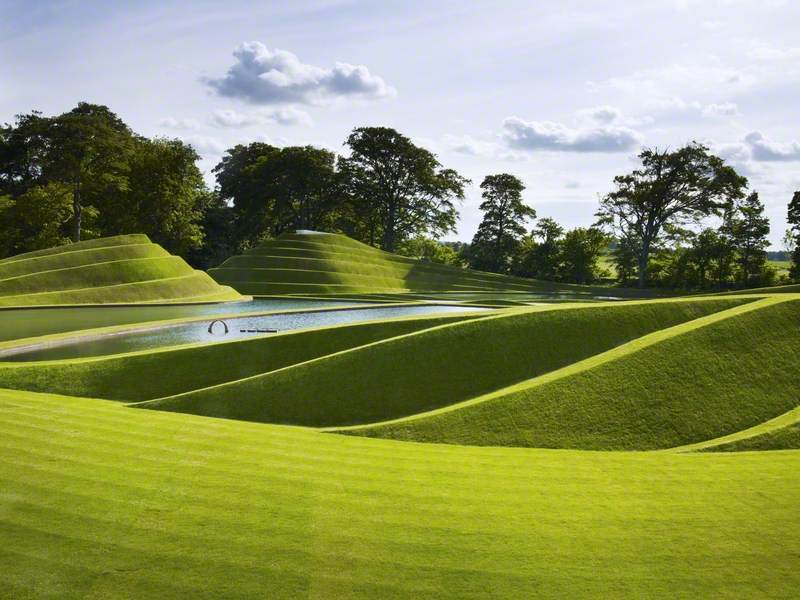 Charles Jencks (1939–2019)
Charles Jencks (1939–2019) -
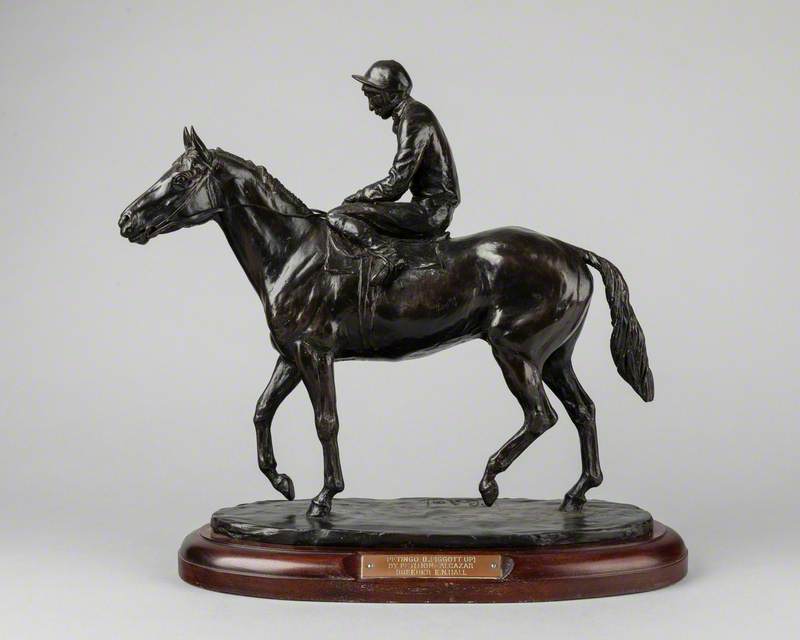 Philip Blacker (b.1949)
Philip Blacker (b.1949) -
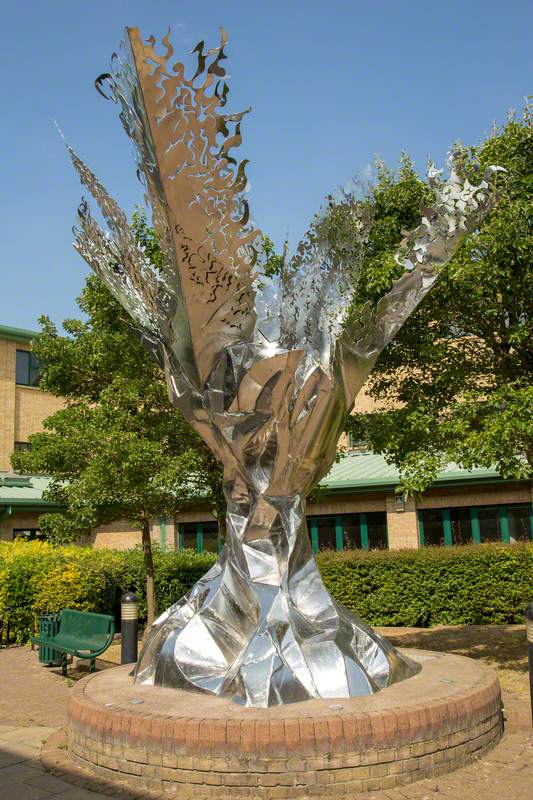 Simon Packard (b.1960)
Simon Packard (b.1960) -
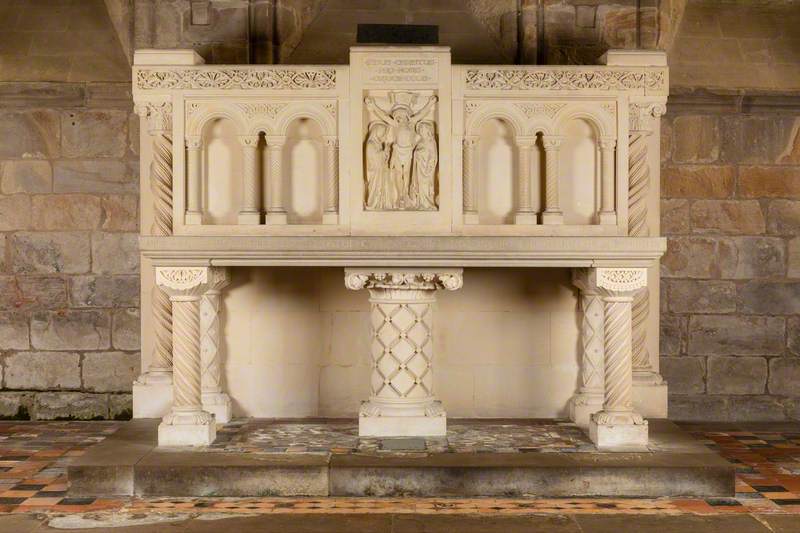 Messrs Hicks & Charlewood
Messrs Hicks & Charlewood -
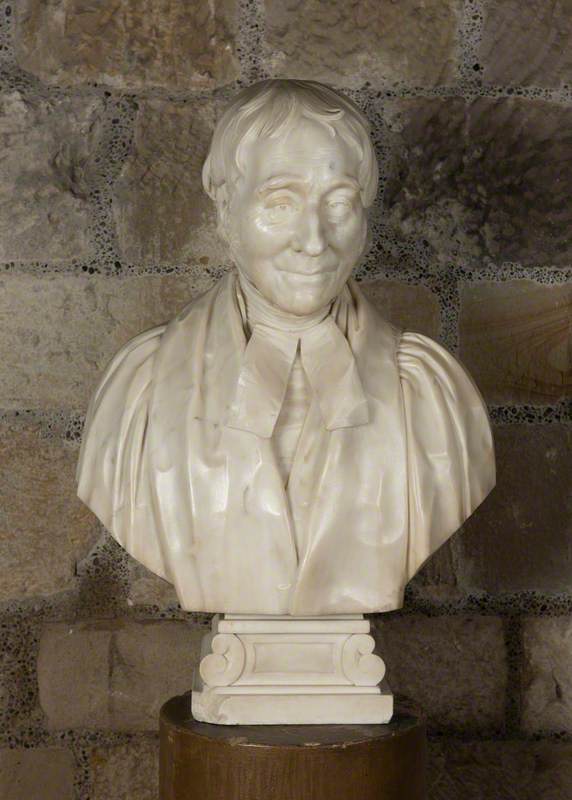 Charles Raymond Smith (c.1799–1888)
Charles Raymond Smith (c.1799–1888) -
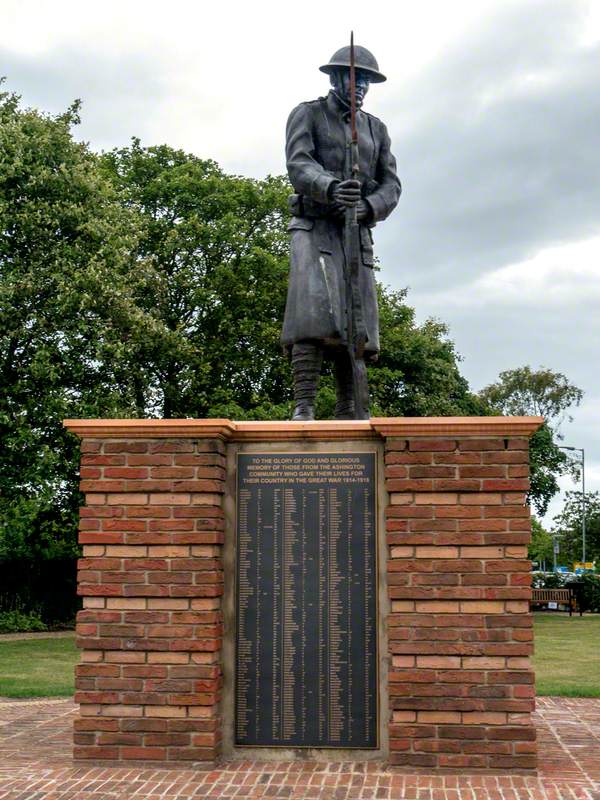 Tom Maley (b.1962)
Tom Maley (b.1962) -
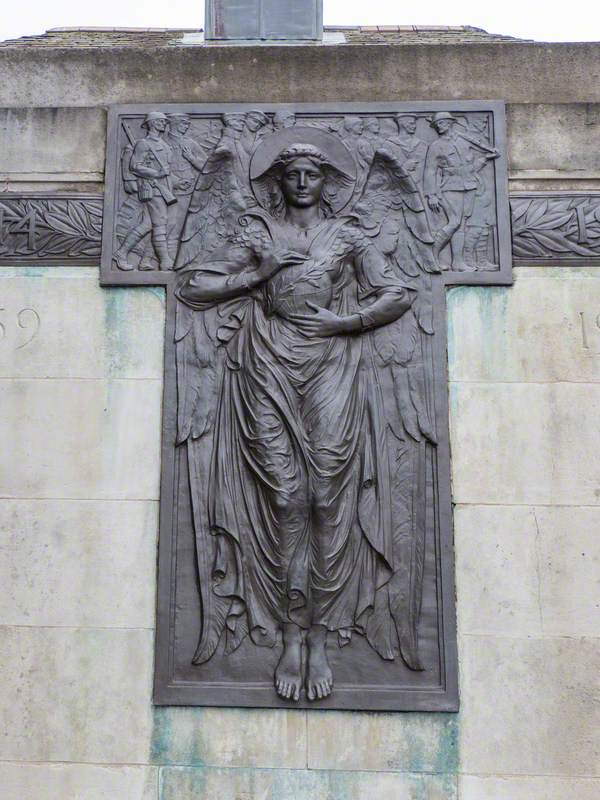 John Reid (c.1890–1968)
John Reid (c.1890–1968) -
 Anthony Salvin (1799–1881)
Anthony Salvin (1799–1881) -
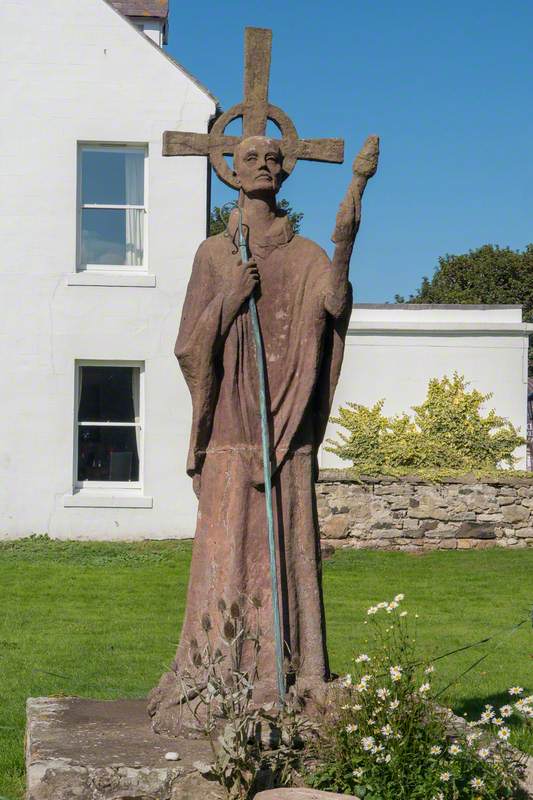 Kathleen Parry
Kathleen Parry - View all 18
